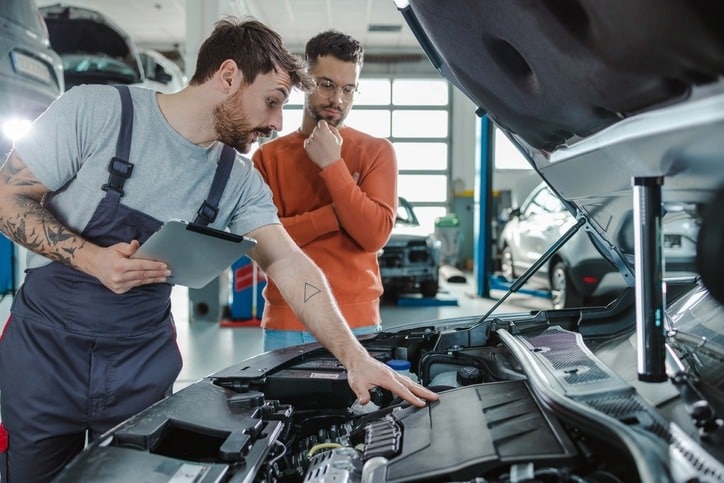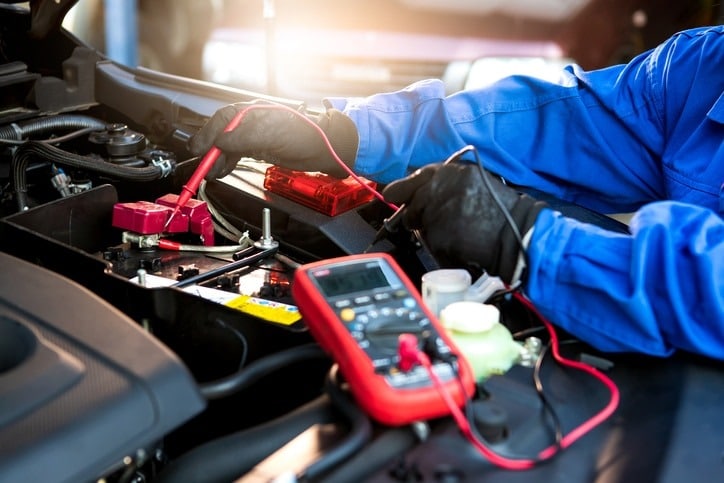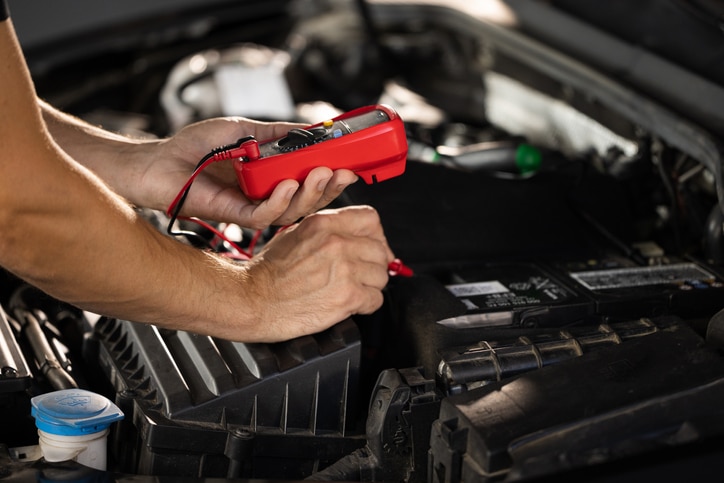How do Vehicle Collision Repairs Differ for EV vs. ICE?

Electric vehicles (EVs) are quickly filtering into the consumer market and beginning to dominate the roads as car manufacturers race to meet targets for zero-emission vehicles by 2035. But as more customers switch to fully electric and hybrid vehicles from ICE (internal combustion engine) vehicles, body shops should already be thinking about tackling the challenges of EV repairs.
What considerations do body shop teams need to factor in for EV collision repairs compared to ICE vehicles? How do the procedures and skills required differ, and why? Will they take up more time and resources? Whatever questions you have, our guide to the differences between collision repairs for ICE and EV vehicles can provide the answers.
ICE vs. EV Collision Repair: What are the Differences?
When it comes to vehicle collision repairs, there might be some variations in the skills and tools required for EVs compared to ICE vehicles, alongside the amount of time needed to complete jobs. Below we’ll provide an overview of the three main differences and how these might affect your body shop.
Different Skills Required
To repair electric or hybrid vehicles, a specialised set of skills is required. This includes the ability to remove and replace high voltage components, diagnose and fix HV electrical faults, and work with the electrical fixtures unique to these types of vehicles. It’s important to have a thorough understanding of these components and systems to ensure you’re carrying out safe and effective repairs for your customers.
Different Tools & Equipment Needed
The tools and equipment used to diagnose and repair these electrical systems are also different from those used in traditional ICE vehicles. For example, EVs may require specialised diagnostic equipment, charging stations, and battery service tools. While your body shop might have a few of these tools for testing and working on the smaller number of electrical components in ICE vehicles, it’s typically worth investing in equipment specifically designed to handle the unique needs of these types of vehicles.
It Can Take More Time to Repair EVs

Electric vehicles (EVs) can sometimes take longer to repair compared to traditional internal combustion engine (ICE) vehicles. This is because EVs have electrical components mounted and placed in different areas within the engine bay and elsewhere inside the vehicle. For instance, Tesla cars have many mounted electrical components, which must be detached to reach certain areas of the vehicle. Additionally, the high-voltage battery used in EVs and alternative fuel vehicles can also add time to the repair process because it requires removal and handling that isn’t necessary for ICE vehicles.
Do EVs Really Take Longer to Repair Compared to ICEs?
Data shows that EVs can take around 14% longer to repair than their ICE equivalents, depending on the repair job. The main factor that causes delays for many of these types of jobs is ordering and receiving replacement parts. Whether you’re replacing the charging port or replacing a damaged HV battery, the parts for these types of vehicles can be in short supply and might even take a few weeks to arrive in some cases. As a result, repair jobs can be delayed before your team even begins to work on the issue. This is worth noting and communicating to any EV or hybrid vehicle customers when they come to you for repairs.
Preparation for the jobs may also take longer because electrical connections and mounted components might need to be removed or detached. This will vary based on the make and model of the vehicle, so bear in mind that no two jobs are likely to be the same in terms of time regardless of how similar the task is.
Costing an EV Job: Things that May Require More Time & Resource
Interestingly, the average cost of repairing alternative fuel vehicles (AFVs) is almost 30% higher than ICE vehicle repairs, while hybrids appear to have the highest costs attached for working on repairs at an average of 66% higher than ICE.
The cost of any collision repair job is heavily dependent on the time and resources required. As suggested above, fully electric and hybrid vehicles tend to take longer to repair, which could lead to higher costs for your body shop. So when it comes to costing these jobs, deciding what to charge clients and being prepared for the amount of time and resources you’ll need to exert, here are a few costing considerations.
Battery being isolated or powered down
The battery of an EV vehicle will either need to be removed or powered down before carrying out any repairs, which can increase the time needed to complete a job. If the battery needs to be powered down, this typically takes less than an hour. But for certain repairs which require battery removal, you should expect this to add around four hours to the total labour.

Parts
Parts for EV vehicles can be more difficult or expensive to supply. Many EVs are high-end vehicles, and the most expensive part is often the battery. This is because they cost so much to manufacture and need to work correctly. Ineffective or damaged batteries are currently the top cause of EV and hybrid vehicle write-offs, which puts pressure on body shops to source the right parts and fit these without issues. Therefore, not only is there a higher cost involved for your shop, but there will also need to be a significant amount of resources behind jobs involving high-voltage batteries.
Other electrical components and parts can also be difficult to source. During the pandemic for example, there were supply shortages for semi-conductors which are a vital component for maintaining many EV and AFV batteries. This not only halted production but also meant that body shops were struggling to find parts to repair faulty charging mechanisms.
EV Materials
EVs are often constructed using lightweight materials such as aluminium and carbon fibre to balance out the weight of the heavy battery. For reference, data suggests that on average, EVs are approximately 200 kilograms heavier than the typical ICE vehicle. While using lightweight materials is effective for reducing the overall weight of these types of vehicles, it can make repairs more challenging. Common collision repairs such as dents aren’t as simple to fix and might require specialist equipment and training, for instance. This can increase the amount of time and money that needs to be spent on what would normally be a quick and cheap job for an ICE vehicle.
Batteries and Heat Contact
The high-voltage batteries in EVs aren’t designed to come into close contact with heat, which means that for paintwork repairs, the vehicle may need to stay in the heat booth at a lower temperature for longer. Some AFVs (alternative fuel vehicles) may call for different drying methods if infra-red isn’t suitable. This is typically a reason for powering down or removing the HV battery since it wouldn’t be safe to leave it inside the vehicle during the drying and curing process.
Specialist Training
Since EVs are still fairly new to the market, it’s important to undertake as much specialised training as possible to ensure that your staff and collision repair specialists are EV-ready as they become more common. The goal is to handle EV collision repairs to the same standard as ICE vehicles. This involves not only understanding the different components of an EV and how they work but also being trained in safety precautions, proper repair procedures, and handling, repairing, and replacing high-voltage batteries.
HV batteries are the most significant difference between ICE and EVs. HV batteries store large amounts of electrical energy, which can be dangerous if not handled correctly. Therefore, your team should be given plenty of training to ensure everybody understands the associated risks with HV batteries and can handle them safely. Specialist training for EV collision repair should cover a wide range of topics, including identifying and diagnosing EV-specific issues, repairing or replacing EV components, and performing EV-specific maintenance tasks. It’s also important to stay up to date with the latest technology and best practices for EV repair, as the technology continues to evolve rapidly.
As EVs increase in popularity, body shops must take the time to understand the differences in how to tackle all types of repairs on these types of vehicles. From costing EV collision repairs to the different parts and skills required, we’ve covered all the major differences in this guide.
For more expert tips and advice geared towards automotive professionals, check out the JTAPE blog.


